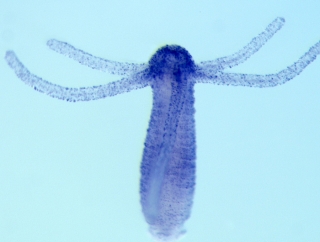By peering deep into evolutionary history, scientists at the University of California, Santa Barbara have discovered the origins of photosensitivity in animals.
The findings are published in this week's issue of the scientific journal PLoS ONE. The scientists studied the aquatic animal Hydra, a member of Cnidaria, which are animals that have existed for hundreds of millions of years. The authors are the first scientists to look at light-receptive genes in cnidarians, an ancient class of animals that includes corals, jellyfish, and sea anemones.
"Not only are we the first to analyze these vision genes (opsins) in these early animals, but because we don't find them in earlier evolving animals like sponges, we can put a date on the evolution of light sensitivity in animals," said David C. Plachetzki, first author and a graduate student at UC Santa Barbara. The research was conducted with a National Science Foundation dissertation improvement grant.

